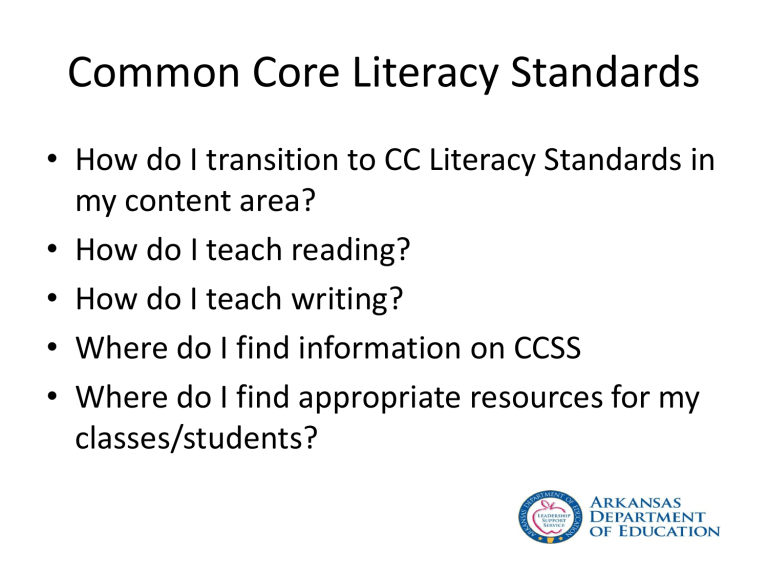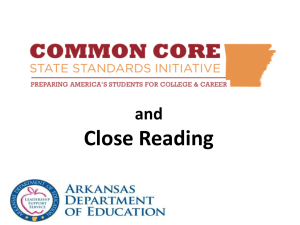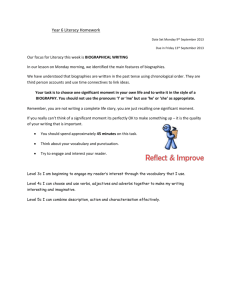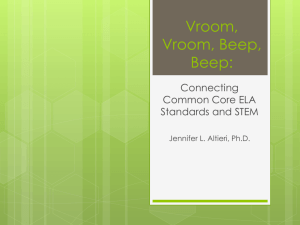Close reading - adesocialstudiesplace

Common Core Literacy Standards
• How do I transition to CC Literacy Standards in my content area?
• How do I teach reading?
• How do I teach writing?
• Where do I find information on CCSS
• Where do I find appropriate resources for my classes/students?
Common Core State Standards for
English Language Arts & Literacy in
History/Social Studies, Science, and Technical Subjects
• What do you know?
• What do you need to know?
• How can I help you?
• How can you help each other?
• Where can you find the answers?
Close Reading of
Complex Text
“A significant body of research links the close reading of complex text— regardless if the student is a struggling reader or advanced—to significant gains in reading proficiency, and finds close reading to be a key component of college and career readiness.”
PARCC Model Content Frameworks for ELA/Literacy p. 6
PARCC Model Content Frameworks
“Close, analytic reading stresses engaging with a text of sufficient complexity directly and examining its meaning thoroughly and methodically, encouraging students to read and reread deliberately.”
PARCC MCF, page 6 http://www.parcconline.org/parcc-content-frameworks
Sign up for email notices
Directly from PARCC
PARCC Content Frameworks
What CC Literacy Standards are
NOT
• … just having students read and write more
• … assigning more vocabulary words to look up and write definitions for
• … conducting basic literacy techniques to struggling readers during class time
What CC Literacy Standards are NOT
• … giving students Venn diagrams and sentence diagramming assignments in social studies
• …assigning more “What did you do during …” essays
What They Are
• Modeling and scaffolding what reading in your subject area looks and sounds like
• Teaching students what is important/vital information in your discipline
Key Features of the Standards
Reading: Text complexity and the growth of comprehension
“…equal emphasis on the sophistication of what students read and the skill with which they read.”
CCSS Introduction, page 8
“Staircase” of Increasing Text
Complexity
• CCSS Reading Standard 10
• CCSS, Appendix A, page 10
CCSS, K-5, pages 11-12
CCSS, 6-12, pages 37-38
Text Complexity
Qualitative
Purpose, structure, clarity, knowledge demands an attentive human reader
Quantitative
Reader and
Length words, sentences, text; word difficulty, frequency
Task
Motivation, knowledge, experiences, complexity of task & questions asked computer software
Educator s’ professional judgment is often best measured by
CCSS Implications for
Classroom
•
More nonfiction
• More research
– begins in earlier grades
– both short and extended research
•
Higher text complexity
•
More teacher collaboration
– across grades
– across content areas
CCSS Implications for
Classroom
• Everyone a literacy teacher
– reading and writing emphasis
• Teachers tell/summarize less and use more scaffolding
• Teaching students to read as
– Scientists
– Historians
– Mathematicians
– Economists
– Geographers, etc .
• More responsibility placed on students for their learning
Reading more complex texts requires reading like a detective
15
• Harder to read writing styles
– Not chronological
– Flashbacks
– Foreshadowing
• Irrelevant or distracting information
• Reader knowledge base
• Understanding nuances/inferences
Close Reading Requires:
• Understanding your purpose in reading
• Understanding the author’s purpose in writing
• Seeing ideas in a text as being interconnected
• Looking for and understanding systems of meaning
• Engaging a text while reading
• Getting beyond impressionist reading
• Formulating questions and seeking answers to those questions while reading
Establishing a Routine for
Close Reading
1. Pre-teach the vocabulary and concepts.
2. Set a purpose for reading.
3. Model close reading.
Establishing a Routine for
Close Reading
4. Provide guided practice and check for understanding.
5. Provide independent practice.
6. Organize discussions and debates.
7. Have students write about the text.
Adapted from the Consortium on Reaching Excellence in Education, Inc
Comprehension Strategies All Good
Readers Use
Pre-reading
• Review vocabulary
• Make predictions
• Review text features
(brainstorm, predict, skim, assess prior knowledge)
Comprehension Strategies All Good
Readers Use
While reading
• Monitor for understanding; reread if needed; summarize
• Draw a visual representation of the unfolding argument
• Ask questions about the main ideas as they unfold; infer
• Make note of unfamiliar words, concepts, ideas to research later
Comprehension Strategies All Good
Readers Use
After reading
– Summarize and restate the text’s main points
– Compare notes with other students
– Discuss what you read
– Reread, confirm predictions, reflect, question
Strategies for Close Reading
• Story Mapping
• SOAPS
• Text-Self-World Connections
• Three Levels of Questions
• Arguments and Evidence
• Appeals – Logical, Ethical, Emotional
• Assumptions
Reading for SOAPS
• Speaker –
– Who is the Speaker? The voice behind the text; what do you know/learn about him/her from reading the text? What authority does this person have to deliver the message?
• Occasion –
– What is the Occasion? The time and place of the piece; the situation that provoked or moved the writer to write?
• Audience –
– Who is the Audience? The group of readers to whom the piece is directed. How is the message tailored to the specific needs of a group?
Reading for SOAPS
• Purpose –
• What is the Purpose? The reason behind the text; why it was written? What is the goal of the speaker? Why does this text exist? What does the author want the reader to think or do as a result of reading this?
• Subject –
• What is the Subject? The general topic, content, ideas contained in the text. Is it specific or general, abstract or concrete, current or timeless?
Connections
Four fundamental ways we relate to text:
1. Text to Self - How does this text relate to me?
2. Text to Itself - What are the distinguishing features of this text?
3. Text to Text - How is this text similar to other texts?
4. Text to World - Why does it matter for people to read this text?
Three Levels of Questions
• Level One Questions: Right There
The answers to these questions can be found explicitly in the text. These are most often who, what, when, and where kinds of questions. They work on the factual level and establish evidence of basic information.
• Level Two Questions: Think and Search
The answers to these questions are not found explicitly in the text – the reader has to infer, interpret, or analyze. They are what the text suggests but does not say. These are often how and why questions.
Three Levels of Questions
Level Three Questions: Author and Me
The answers to these questions go beyond the text and are often found in parallel situations outside the text. The reader has to analyze, synthesize, and/or evaluate, using the text as a guide to explore larger issues. They often require outside knowledge or experience to answer.
SCAFFOLDING
Definition - a temporary structure put up to allow you to work the text in a way that wouldn't be possible w/o the scaffold.
• It is NOT a reading assignment, which treats kids as independent readers.
29
Close reading
Disciplinary Literacy
• Predominates middle school to high school
• What does it mean to read, write, and think through a disciplinary lens?
• Navigate texts from unrelated & distinct disciplines
– math, science, history, geography, music, art
Types of reading required
Literary fiction,
Math
Science - biology, phys. sci., history, social studies, economics, technical subjects, health, fitness, humanities – art, music
DISCIPLINARY
LITERACY
INTERMEDIATE
LITERACY streamlining and multitasking phase
BASIC LITERACY
Doug Buehl (2011) taken from
Shanahan and Shanahan (2008)
Informational texts/literary nonfiction
• Personal essays, opinion pieces, speeches
• Essays about art or literature
• Biographies and memoirs
• Journalism (newspapers in the classroom)
• Historical, scientific, technical, or economic accounts written for a broad audience
(Nonfiction sources in library)
• Digital sources (like EBSCO magazine index)
Common Core State Standards, p. 57
Disciplinary literacy
• Specific ways of reading and writing in the disciplines of history, social studies, science and technical subjects
• What if I'm expected to behave as a certain kind of thinker? Scientist, historian, mathematician…
33
Disciplinary Reading Range and
Content
• Critical to building knowledge in content areas
• Requires an appreciation of norms & conventions of each discipline
• Necessitates an understanding of domain- specific words and phrases
• Calls for an attention to precise details
• Demands the capacity to evaluate intricate arguments, synthesize complex information , and follow detailed descriptions of events and concepts
Student Lens to Historian Lens:
Student lens
• Fact collecting
Historian lens
• Notice why’s and how’s
• Textbook
• Notice who’s, what’s, where’s, and chronology of events
• Truth statements
• Read a variety of texts critically
• Notice cause/effect relationships and hypotheses
• Critically examine
Lesson Plan Makeover
Can you add any of the following to current lessons, units?
• Interesting problems
• Investigations
• Debates
• Simulations
• Games
• Socratic questioning
•
• Projects and presentations
"Common Core Connections." Book Links 21.4 (2012): 30. MAS Ultra - School Edition. Web. 25 May 2012. Lesson ideas with standards
Revise a Lesson
Describe a lesson you taught --
Determine Bloom’s level --
How would you revise--
Student reading assignments
Student work
Strategies
Assessment
Sample Common Core Lesson
• Read aloud the original version of “The Three Little Pigs”.
• Guide student discussion of characters, setting, point of view, climax and resolution.
• Ask students how different the story might be if the wolf could tell his version of this story.
• Read aloud The True Story of the Three Little Pigs by A. Wolf by Jon
Sciezka.
• Again discuss characters, setting, point of view, climax and resolution.
• Ask students the definition of compare and contrast. Ask what type of graphic organizer they could use to compare and contrast the two books we just read.
• Draw a Bubble Map (or other appropriate graphic organizer on the board. Lead a class discussion of similarities and differences in the two books.
• Have students give examples of similarities and differences and the correct placement on the map.
Day 2
• In small groups, have students select a familiar fairy tale picture book to read. Then students will retell the story from the point of view of a character other than the hero or heroine. For example, the witch in Hansel and Gretel, the huntsman in Snow White, the giant in Jack and the
Beanstalk.
• Have students fill out another Bubble Map showing how their story is different when it is told by a different character.
• Have students share their stories with their group, or publish as a class book of “Untold Fairytales”.
• As a class, discuss how the story changes when told from a different point of view.
Fractured fairy tales
• http://www.readwritethink.org/classroomresources/student-interactives/fracturedfairy-tales-30062.html
• Interactive site from ReadWriteThink – for classroom use.
Free resources abound
• Library media wiki Hooray for Books
• Social Studies Place wiki
• Library of Congress (LOC.gov)
• “What Every Educator Needs to
Know…” resources pages (Lucy) document
• Achievethecore.org
43
More free stuff for lesson plan makeovers
• Thinkfinity, ReadWriteThink
• SAS Curriculum Pathways
• Primary Sources—loc.gov
EVEN MORE Free
Resources
• Arkansas Traveler Data Base – AR State Library
• World Book Online – research tools include dictionary, atlas, local and country research guides, and more.
• Britannica Resources –
www.library.arkansas.gov/traveler
World Book Web
• World Book Kids
– Grades K-5
• World Book Student
– Grades 4-9
• World Book Advanced
– Grades 8-12 & College
World Book Advanced
• Primary source documents
• e-Books
• Timeline & citation builder
• Current magazine selections
• Individual research accounts
• Classroom activities, lesson plans, & discussion guides
Primary sources at your fingertips
Students can find thousands of original, eyewitness, and historical source documents as well as important works of literature.
Students are able to view images of the original documents
ADE Username: ardep
Password: ardep
Pathways: Science http://pathways.eb.com
Smartmath Practice http://ARmath.eb.com
Image Quest http://quest.eb.com
21 st Century Explorer http://explorer.eb.com
Britannica School Edition http://school.eb.com
Maggie Herrick
Margaret.herrick@arkansas.gov
501-682-6584






